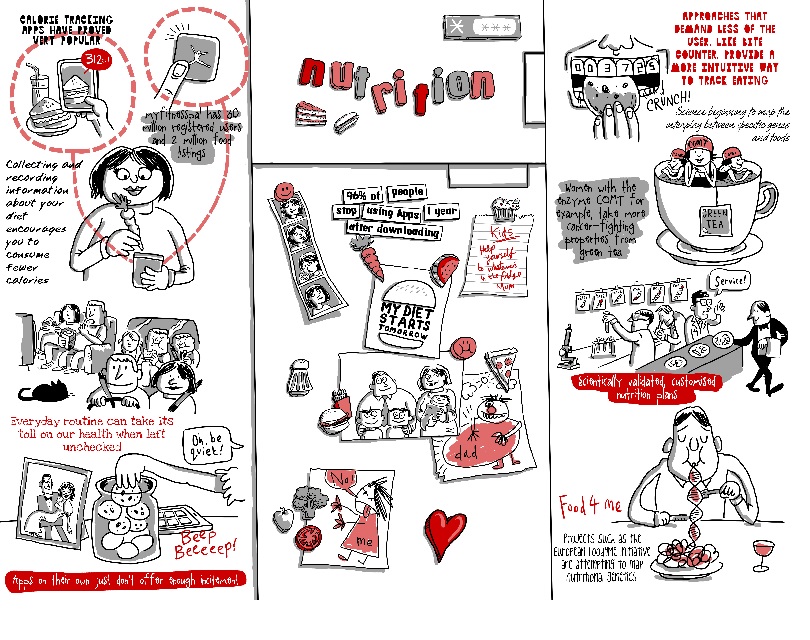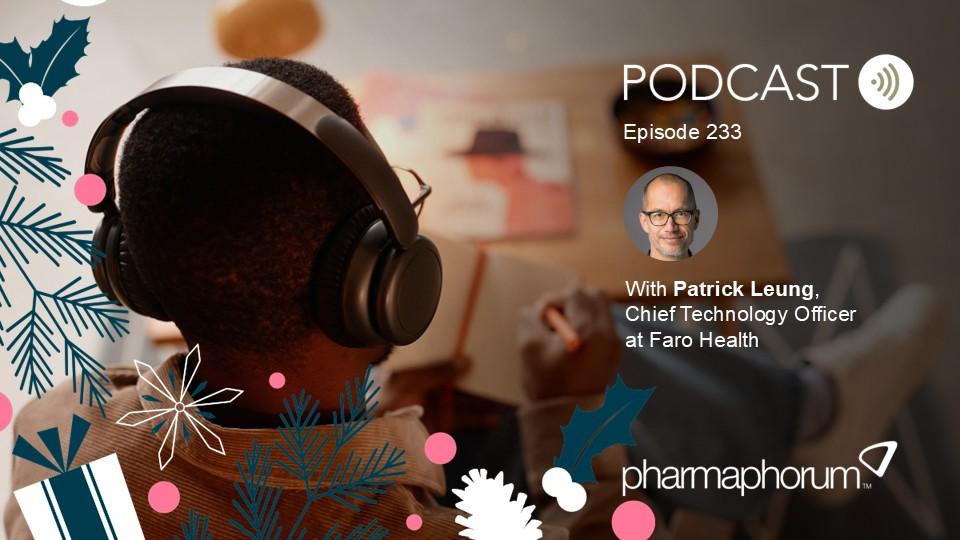Your health, yourself: Marta’s nutrition mission

In the second part of a new series by Ogilvy CommonHealth Worldwide on the quantified-self movement, we meet Marta who is going on a diet and wants to use apps to help her with her with her weight loss.
(Continued from "Your health, yourself: Thiery's technotraining")
Over the course of this series you will be introduced to Thiery, Marta, Claude, Dana and Harry – each of whom (like most of us) have specific health concerns to deal with and / or wellness goals to reach. As both consumers and patients today, they have access to a wide range of personalised technology that promises to smooth their path to wellbeing. But whilst in theory these individualised offerings are more effective than traditional approaches, in reality success is far from guaranteed. It seems that even though health information is readily available at the touch of the button or a swipe of the finger, it is rarely packaged in a way that is truly relevant and meaningful to us as consumers.
Meet Marta. At 24 years old, she's just left university armed with a master's degree and an extra 10 cms around the waist. Now Marta is getting married and she wants to go on a diet to get in shape for her big day. So what does she do? Well what any young, Wi-Fi connected dieter with a specific weight loss goal would do of course. Marta downloads a calorie tracking app, plugs in her info, sticks to her personalised plan and watches the pounds melt away...
It's not an implausible scenario by any means. Just like we saw in the fitness sector, a plethora of digital solutions exist to aid dieters like Marta – ready to collect personal data, create personalised plans, record personal eating habits and track personal weight loss through a simple website or smartphone app. And just as was the case for Thiery, these apps and devices prove effective for our motivated bride-to-be. After all, experts agree that collecting and recording information about your diet encourages you to consume fewer calories, and personalised interventions have been shown to promote long-term weight loss1,2.
So it seems like Marta can't (or rather can) lose. But exactly who are the sugar-free fairy godmothers helping her on her journey? Established diet giants like Weight Watchers®, Slimming World and Jenny Craig® have introduced services that let consumers monitor their calorie intake and physical activity, but apart from them the main players are smaller set-ups from outside the traditional dieting sector. MyFitnessPal, for example, is a free and easy-to-use app that provides consumers with flexibility and freedom to fit healthy eating into their individual lives. To date, the programme has 30 million registered users and 2 million food listings3.
So Marta has logged-on and shifted-off those extra pounds. The big day arrives and everyone agrees that she looks absolutely FAB in the photos. But what happens if we fast forward a few months into the future...? Just 12 months on, as Marta celebrates her first wedding anniversary with husband Karl, we find that our bride has joined the 96% of app users who stop using a programme within 1 year after downloading it4. As a result Marta's weight has started to creep up, and she's looking longingly at those framed photos on the mantelpiece. It seems that without the personal motivational target of getting slimmer for her 'big day', the apps on their own just don't offer enough incitement to put down those potato chips.
And what about if we take a dive even further into the future? Fifteen years later, Marta's family has expanded to include teenage twins and a young daughter. But that's not the only thing that's grown. Karl was feeling pretty smug back during Marta's dieting days, when he could eat what he wanted without ever changing shape. Now it's a different picture. Karl is every cardiologist's worst nightmare – overweight, high blood pressure, cholesterol that is through the roof and Type II diabetes. Could the stresses of family life be to blame? The twins, 13, have suddenly shot up 12 cms and are constantly asking to be ferried to their intensive schedule of after-school activities, often missing family meals as a result. The youngest, Sophie, hasn't grown out of her baby fat and is proving to be a spoilt and fussy eater. Between them, Marta's clan has a variety of very specific nutritional and health requirements. It has been no use trying to get Karl to follow a smartphone based weight loss app like she so successfully used pre-wedding. And as for the kids?! She's worried they might not be getting the necessary nutrition they need, but she's not entirely sure what to do about it.
Whilst personalised nutrition has to date stuck close to the topic of weight loss (and for good commercial reasons), the next step will be to apply existing knowledge and technology to address a variety of nutritional needs. It will also involve the creation of approaches that are increasingly intuitive, accessible and less demanding for the end user. Instead of manually calculating calories, perhaps Karl would have more luck with an automated system such as the 'Bite Counter' device5, essentially a pedometer for your dinner. And what about addressing his blood pressure by tracking salt intake, or cholesterol with saturated fat? Is there a service that could help ensure that the teens are getting a nutritionally balanced diet suited to their active lifestyle, age and gender, even when they are away from Marta's watchful gaze and faced with the lure of the school vending machine? And now that Marta has finally steadied the scales after years of yo-yo dieting, is there a tool that could help her maintain her weight, rather than head for a specific weight-loss target?
Perhaps what Marta and her family need is to get even more personal. What kind of individualised nutritional information could they get by looking at their DNA? The link between our genes and what we eat is an area that is starting to receive increasing attention, meaning we may soon have a whole new individualised spin to 'eat this, not that!' Current research has reached a stage where it can show that certain foods enhance the action of protective (or harmful) genes, whilst others tend to suppress them. As just one example, scientific studies in America have proven that Pima Indians from the Southwest get Type II diabetes at eight times the rate of the White American. The hope is that with more detailed genetic profiling, we can replace blanket 'fad' recommendations (like one glass of red wine a day) with scientifically validated customised nutrition plans. This could allow food manufacturers and retailers to provide unique meal solutions to help consumers battle specific diseases.
Mapping out how specific genes interplay with our food intake is not going to be a short or easy task. But there are already some interesting results that hold potential for the future. Women with the gene enzyme COMT for example, are thought to take more cancer-fighting benefits from green tea than others. And most relevant for Marta's family, is the discovery that certain people with the E4 gene for protein (27% of the UK population6) are at an increased risk of diabetes and high cholesterol. The good news is that if you know you have this gene and take adequate steps to combat it – stop smoking, give up alcohol, exercise regularly, and so on – you can remove the genetic predisposition entirely.
What could this mean for Karl? So far he hasn't paid much attention to his cardiologists repeated pleas to avoid the extra servings of chips. And perhaps this behaviour isn't entirely irrational – after all, GPs routinely put people on low salt diets to control high blood pressure even though evidence suggests that it doesn't work for as much as half the population. But what if he found out that his specific genes put him at increased risk of high cholesterol? Would this knowledge make him more likely to finally change his health behaviour for the better?
The potential for the food industry to capitalise on this research in the future is tremendous. And in the meantime, the wealth of health data on food choice and related nutrient intake that manufacturers and retailers have amassed over the years could be shared with the scientists attempting to map out our nutritional genetics. One such project is the European Food4me7 initiative – it's certainly something for Marta and the gang to look out for in the future...

Health highlights:
The multi-million Euro weight-loss industry has created a natural demand for personalised nutrition.
Future success rests on expanding this model to a variety of nutritional needs, as well as ensuring approaches are less labour intensive and longer-lasting.
Do:
• Provide personal health information beyond calories
• Collaborate with food scientists to explore the potential of personalised nutrition based on individual DNA
Don't:
• Assume all users have a fixed and motivating long-term goal
References
1. Cheskin LJ. A personalised intervention reduced weight regain in overweight and obese adults who had recently lost weight. Evid Based Med 2008;13:109.
2. Hollis JF, et al. Weight loss during the intensive intervention phase of the weight-loss maintenance trial. Am J Prev Med 2008;35:118–26.
3. Business Wire. MyFitnessPal community reaches 30 million users, extends reach through new API. Available at: http://www.businesswire.com/news/home/20121016005540/en/MyFitnessPal-Community- Reaches-30-Million-Users-Extends (Last accessed May 2013).
4. Daily Mail. Women have tried 61 diets by the age of 45 in the constant battle to stay slim. Available at: http://www.dailymail.co.uk/health/article-2117445/Women-tried-61-diets-age-45-constant-battle-stay-slim.html (Last accessed May 2013).
5. Bite Technologies. Calorie counting made easy. Available at: http://www.icountbites.com/ (Last accessed May 2013).
6. University of Reading. The ApoE gene fact sheet. Available at: http://www.reading.ac.uk/web/FILES/reas/EthicsGenotypeFactsheets.pdf (Last accessed May 2013).
7. Food4Me. Available at: http://food4me.org/ (Last accessed May 2013).
The next article in this series 'Your health, yourself: Claude's case of compliance' can be viewed here
About the authors:
Antonia Betts, Managing Director, Ogilvy HealthPR, UK.
Lexi Fletcher, Planner, Ogilvy Healthworld, UK.
Lourdes de Pablo, CEO, Ogilvy Healthworld, Spain.
Closing thought: What is the potential of personalised nutrition based on individual DNA?











